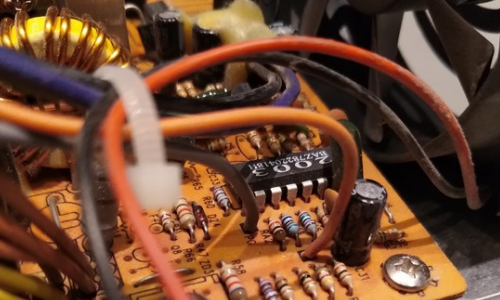OUTLINE:
Understanding of Integrated Circuits for Communications
 153
153In the intricate tapestry of modern communication, a silent force weaves seamlessly through the electronic pathways, shaping our interconnected world – Communication Integrated Circuits (ICs). As we stand on the precipice of innovation, let us embark on a journey to demystify the profound impact of these electronic maestros.
Join us as we delve into the heart of Communication ICs, unraveling their significance and unlocking the key to the seamless flow of information that defines our digital age.

What Are Communication Integrated Circuits[IC]
Communication Integrated Circuits (ICs) are sophisticated electronic components designed to facilitate the transmission, reception, and processing of information in communication systems.
These circuits play a crucial role in enabling various forms of communication, including voice, data, and multimedia, across a wide range of devices and applications.
Communication ICs are engineered to perform specific functions within communication systems, such as amplifying signals, modulating and demodulating data, filtering frequencies, and managing the flow of information.
They are integral to the operation of devices like smartphones, routers, modems, and other communication equipment.

These circuits contribute to the efficiency and reliability of communication systems by optimizing signal quality, managing power consumption, and ensuring the seamless transfer of data between different components.
As technology continues to advance, Communication ICs evolve to support higher data rates, improved performance, and enhanced connectivity, playing a foundational role in the interconnected digital landscape of the modern world.
What Are the Three Types of Communication Integrated Circuits
Communication Integrated Circuits (ICs) can be categorized into various types based on their functions and applications.
While it's challenging to pinpoint only three specific types, as there are numerous variations, here are three broad categories:
1. Radio Frequency (RF) Integrated Circuits:
- These ICs are designed to handle signals in the radio frequency spectrum.
- Examples include RF amplifiers, mixers, and frequency synthesizers.
- RF ICs are crucial in wireless communication devices like cell phones, Wi-Fi routers, and satellite communication systems.
2. Audio Integrated Circuits:
- Audio ICs are tailored for processing and amplifying audio signals.
- This category includes audio amplifiers, codecs, equalizers, and audio processors.
- They are vital components in devices such as audio amplifiers, speakers, headphones, and audio processing systems.
3. Data Communication Integrated Circuits:
- These ICs are focused on the transmission and reception of digital data.
- Examples include modems, network controllers, and transceivers.
- Data communication ICs are essential in networking equipment, such as routers, switches, and communication interfaces in computers.
How Do Communication Integrated Circuits Work
Communication Integrated Circuits serve as the unsung heroes in the world of modern connectivity, orchestrating the seamless exchange of information in electronic devices.
At their core, these circuits manipulate electrical signals to enable the smooth transmission and reception of data, sound, and more.
Whether it's the crisp voice on a smartphone call or the lightning-fast transfer of data between devices, these ICs are the silent architects of these communication processes.
Analog ICs, such as amplifiers and filters, fine-tune signals to enhance their strength and clarity.

In the realm of wireless communication, modulation and demodulation ICs come into play, ensuring that information is efficiently encoded onto carrier signals for transmission and then decoded upon reception.
Operating within specific frequency bands, RF ICs manage signals in the radio frequency spectrum.
They might employ frequency synthesizers and mixers to navigate the intricate dance of frequencies, ensuring signals find their designated paths.
In the digital domain, data communication ICs take center stage. Codecs and serializers/deserializers encode and decode digital data, ensuring that the language of ones and zeros is translated accurately between devices.
In networking equipment, specialized ICs manage the complex choreography of data flow, addressing, and protocol handling.
For audio aficionados, audio ICs like amplifiers and equalizers refine signals to produce the crystal-clear sound that elevates our auditory experiences.
These circuits work tirelessly, often behind the scenes, to deliver the seamless communication we've come to expect in our interconnected world.
What Are the Advantages of Communication Integrated Circuits
Communication Integrated Circuits (ICs) offer several advantages that contribute to their widespread use in electronic devices and communication systems. Here are some key advantages:
Miniaturization and Integration:
Communication ICs are designed to perform complex functions within a single, compact chip. This allows for the miniaturization of devices and facilitates the integration of multiple functions into a single system.
Increased Efficiency:
These ICs enhance the efficiency of communication systems by optimizing signal processing, modulation, and demodulation.
This leads to improved data transmission and reception with reduced signal loss.
Enhanced Performance:
Communication ICs are engineered to meet specific performance criteria, such as signal quality, speed, and reliability.
This results in high-performance communication systems that deliver clear audio, fast data transfer, and reliable connectivity.
Cost-Effectiveness:
The integration of multiple functions into a single chip can lead to cost savings in terms of manufacturing and assembly.
This is particularly beneficial for mass production of electronic devices.
Power Efficiency:
Many Communication ICs are designed with power efficiency in mind, helping to conserve energy in battery-operated devices and reducing overall power consumption in electronic systems.
Versatility:
Communication ICs are versatile and can be tailored to various communication standards and protocols.
This adaptability makes them suitable for a wide range of applications, from wireless communication to wired networking.
The End
Communication Integrated Circuits (ICs) emerge as the silent architects of modern connectivity. From enhancing efficiency to scaling down devices, these circuits orchestrate seamless communication.
Their versatility, reliability, and cost-effectiveness lay the groundwork for a connected future. As technology advances, Communication ICs stand poised to continue shaping the symphony of our interconnected lives, ensuring the fluent exchange of information across the evolving landscape of integrated circuits.

Disclaimer: The views and opinions expressed by individual authors or forum participants on this website do not represent the views and opinions of Chipsmall, nor do they represent Chipsmall's official policy.

share this blog to:

